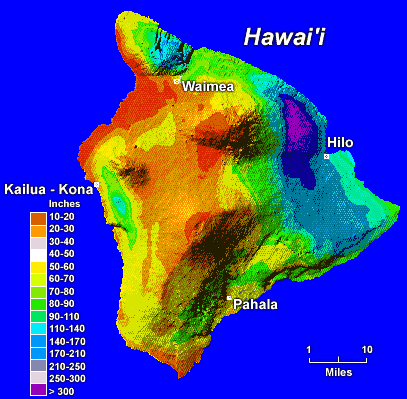It depends on what you are used to. Wiki says:
Hilo features a
tropical rainforest climate (
Koppen Af), with substantial rainfall throughout the course of the year. Hilo's location on the eastern side of the island of Hawaiʻi, (
windward relative to the
trade winds), makes it the third wettest designated city in the United States behind the
southeast Alaskan cities of
Ketchikan and
Yakutat and one of the wettest in the world.
The stats say that Hilo gets 130 inches of precipitation per year, Ketchikan Alaska can get over 200 inches. That being said, "it depends on what you are used to". I lived through 14 years of the SE Alaska rain, Hilo is much preferable. For one, in Hawaii when it rains, its like the heavens open up and a flood falls from the sky. Some people say thats the worst part of the rain, but it isn't. Would you rather get 7 inches of rain over a 24 hour period and be more or less done with it until the next dump, or have the 7 inches start on April 7th and end on May 1st, with absolutely no break in between? (and then start again on May 3rd and continue for another 30-60 days, non-stop, without ever getting a break? Would you rather get your rain at tropical temperatures, or just above freezing? And of course, you don't have to shovel rain. For at least 4 months out of the year the SE Alaska precipitation falls as snow, which has to be moved around, is dangerous to drive in, and causes lots of injuries, can collapse roofs, etc. After experiencing both, Hilo rain is a walk in the park. Wet walk in the park. But yes, there are plenty of sun breaks to enjoy. And besides, if you get sick of it, you can drive for 2 hours and be in the hot dry sun again.
Here's some info for comparison. You might know some place near one of these locations:
Mobile, Ala.: 67 inches average annual rainfall; 59 average annual rainy days
Pensacola, Fla.: 65 inches average annual rainfall; 56 average annual rainy days
New Orleans, La.: 64 inches average annual rainfall; 59 average annual rainy days
West Palm Beach, Fla.: 63 inches average annual rainfall; 58 average annual rainy days
Lafayette, La.: 62 inches average annual rainfall; 55 average annual rainy days
Baton Rouge, La.: 62 inches average annual rainfall; 56 average annual rainy days
Miami, Fla.: 62 inches average annual rainfall; 57 average annual rainy days
Port Arthur, Texas: 61 inches average annual rainfall; 51 average annual rainy days
Tallahassee, Fla.: 61 inches average annual rainfall; 56 average annual rainy days
Lake Charles, La.: 58 inches average annual rainfall; 50 average annual rainy days
If that wasn't too much information, Hilo isn't the wettest part of the Big Island. As you go up in elevation you can go up in rainfall. More info:
RAINFALL – If the islands of the State of Hawaii did not exist, the average annual rainfall upon the water where the islands actually lie would be about 25 inches. Instead, the actual average is about 70 inches. Thus the islands extract from the air that passes across them about 45 inches of rainfall that otherwise would not fall. That the mountains are dominantly responsible for this added water bonus is evident from annual rainfall maps, which show the tremendous amounts of rainfall deposited in mountainous areas in the average year. In many mountainous areas of the State these depths exceed 240 inches, or 20 feet. At Mt. Waialeale, on Kauai, the annual average reaches the extraordinary total of 486 inches – over 40 feet. This is the highest recorded annual average in the world.
Here's a rainfall map that may help:

What's that you say? Still not enough information? Well I'm here to help:
Number of Sunny Days
In the table below, the average number of
Sunny Days for a city in Hawaii is the total days in a year when the sky is mostly clear. This includes the days when cloud covers up to 30% of the sky during daylight hours.
Partly Sunny Days have cloud covering from 40% to 70% of the sky during the daytime. The rest of the days are mainly overcast, with at least 80% cloud cover.
Total Days With Sun is a sum of the Sunny plus Partly Sunny days. All the numbers are annual averages, made from years of weather watching.
City............... Sunny Days.......Partly Sunny Days....Total Days With Sun
Hilo...................36......................... 132............................168................ .(168 by comparison to 86 with Yakutat, Alaska)
Honolulu............90.........................181 ............................271
Kahului, Maui......131.......................145........... .................276
Lihue, Kauai........56........................184........ ....................240
Enough info... No?
Amount of Sun
Here's another way to look at how much sunshine a city gets. The
% Sun number measures the percentage of time between sunrise and sunset that sunshine reaches the ground. Again, these amounts are yearly averages based on many years of weather observations.
Percent sunshine yearly
Hilo...............41%
Honolulu........71%
Kahului......... 67%
Lihue.............59%
So to summarize, it depends on what you are used to. If you are used to Arizona, Hilo will be wet as heck. If you are used to SE Alaska, you'll get almost 100 more days of sun, 30 less inches of rain, and 200 less inches of snow in Hilo.


 Please register to participate in our discussions with 2 million other members - it's free and quick! Some forums can only be seen by registered members. After you create your account, you'll be able to customize options and access all our 15,000 new posts/day with fewer ads.
Please register to participate in our discussions with 2 million other members - it's free and quick! Some forums can only be seen by registered members. After you create your account, you'll be able to customize options and access all our 15,000 new posts/day with fewer ads.